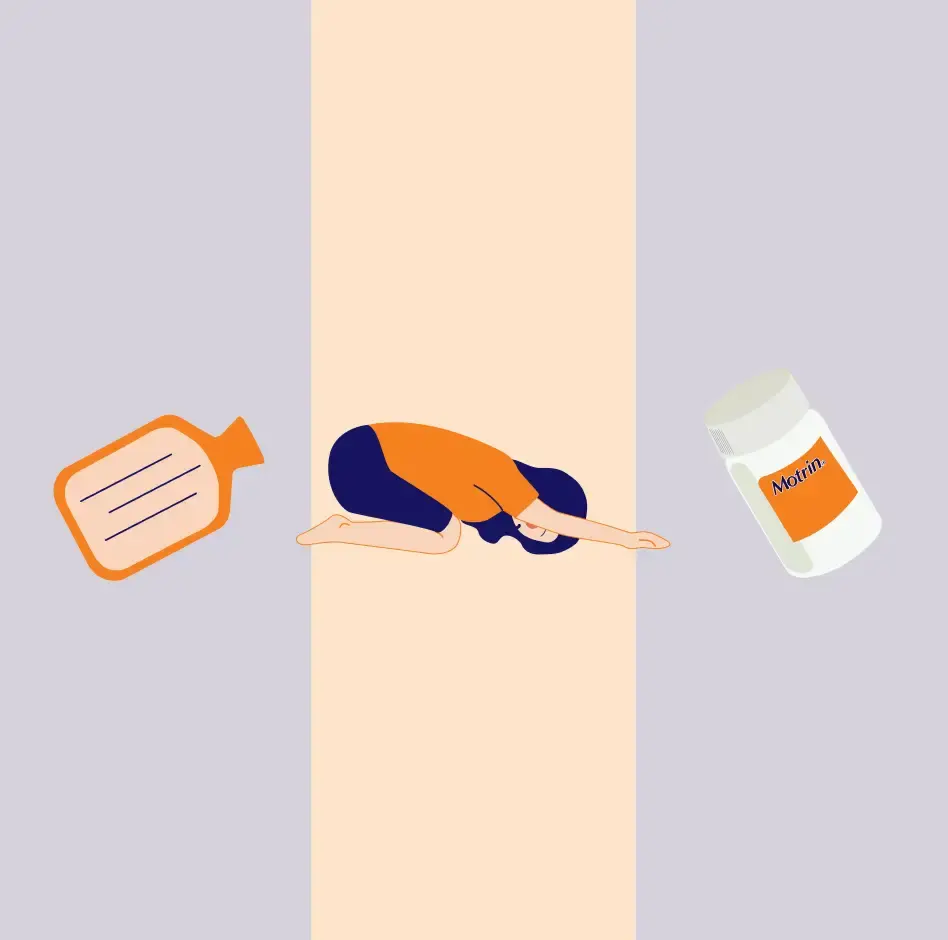Period pain and cramps can affect our day-to-day routines when they strike. So, understanding why and how they originate can be the first step in empowering ourselves, and tackling this discomfort.
Read on for our MOTRIN® guide to the ovulation cycle, and discover how long a period lasts, the various menstrual cycle phases, and how to manage your symptoms today.
What Is the Menstrual Cycle?
The menstrual cycle is a part of the reproductive system. It is comprised of various phases including menstruation (commonly known as a ‘period’) – plus associated signs and symptoms that may accompany it[1].
A cycle is calculated from the moment one menstrual period starts, to the beginning of the next[2].
What Is a Period?
Menstruation, or a period, is the first phase of the menstrual cycle[1]. It is the monthly process by which the lining of the uterus sheds via the vagina[2], and an important phase in the overall health of the female reproductive system.
Here’s how it occurs:
Hormones work together to thicken the endometrium (the lining of the uterus) to prepare it for pregnancy[1].
During this time, the body also experiences ovulation, which is dictated by hormones[1].
However, if a released egg isn’t fertilized during this cycle, the initial preparation for a pregnancy by the uterus isn’t required anymore[2].
The lining will, therefore, shed, which is the bleeding experienced during menstruation, otherwise known as a period[2].
Period Symptoms
During menstruation, you may experience a number of period symptoms. The main one is of course the menstrual bleeding itself, which can be lighter or heavier depending on various factors. However, other symptoms may include[3]:
Cramping in the pelvic and abdominal regions
Tiredness
Headaches
Fluctuations in mood
Feeling irritable
Soreness in the breasts
Bloating
Cravings for food
Many people experience symptoms before the period starts, too[4]. These symptoms are known as premenstrual syndrome (PMS).
PMS is a collection of period symptoms that can appear between one and two weeks before menstruation, and are part of the cycle[4]. They can occur both as physical and emotional symptoms, including[4]:
Issues with sleep
Lack of concentration and memory troubles
Headaches and backaches
Skin complaints
Joint soreness
Cravings for food
Digestive problems such as diarrhea or constipation
Tender and swollen breasts
Bloating
Depression and anxiety
Feeling irritable
Mood fluctuations
Reduced libido
Both PMS and period symptoms are completely normal parts of the menstrual cycle. Many common symptoms can often be relieved with light exercise, by eating nourishing food, and being mindful of your sleep[4]. However, if your symptoms feel a little more difficult to manage, or are worrying you, you should consult a medical professional for advice.
The 4 Menstrual Cycle Phases
Hormone fluctuations control and dictate how the reproductive organs react, and what happens in each phase of the menstrual cycle[1]. There are four defined phases within this cycle, though some of them overlap with one another:
1. Menstruation
The first phase starts on the first day of the cycle. When an egg hasn’t been fertilized, and therefore a pregnancy hasn’t begun, the endometrium sheds via the vagina. This bleeding phase typically lasts between three and five days, but it may also last up to seven[1].
2. The Follicular Phase
This second phase crosses over with the first. It starts at the same time as menstruation, but ends when ovulation begins. During the follicular phase, the amount of the hormone known as estrogen in the body increases, helping the endometrium lining to get thicker. The follicle-stimulating hormone encourages your ovary follicles to grow. Between days 10 and 14, one of these follicles becomes a fully-formed egg[1].
3. Ovulation
Ovulation happens around the 14th day, if your cycle is 28 days long. During this phase, an egg is released by the ovary when luteinizing hormone levels increase. If you’re planning on having a baby, you will typically look to this phase to work out how long after the period you ovulate[6,1].
4. The Luteal Phase
The fourth phase is known as the luteal phase, which starts around day 15 and lasts until day 28. During this phase, the egg released during ovulation makes its way to the uterus via the fallopian tubes.
Progesterone levels increase during this time and ready your endometrium for pregnancy. If a pregnancy doesn’t happen during the luteal phase, hormone levels fall, and the endometrium breaks down to create your period, bringing the cycle back around to the beginning. If an egg is fertilized, however, it will attach to the endometrium, signaling the beginning of a pregnancy[1].
How Long Do Periods Last?
How long a period lasts can vary from person to person, though menstruation typically lasts from three to seven days[1].
It can be normal to experience longer periods when your menstrual cycle begins, and for a handful of years afterward[2]. After a few years, and as we get older, the cycle usually shortens and becomes more predictable[2]. If your period is unusually long and you are worried about the bleeding, be sure to consult a medical professional.
How Many Days Are Between Periods?
The length of time between each period can vary from person to person – and be affected by various factors, such as medical conditions and whether you are taking birth control, for example. Anything between 21 days and 35 days is considered normal, but the average cycle will last around 28 days[1].
What Is Considered the Last Day of a Period?
The last day of your period is the final day where you experience any menstrual bleeding. This could be anything from three to seven days after the first signs of bleeding[1].
Irregular periods
Sometimes, you may experience an irregular period, or your menstrual cycle may not sit within the time of what is considered ‘typical’.
Slight variations in a menstrual cycle can be completely normal[5]. However, if you have any concerns about your cycle, speak to a doctor for medical advice.
What Is Considered An Irregular Period?
A period is a very personal thing, and all cycles are different. Nevertheless, a few things to look out for may include[5]:
Menstruation that happens less than 21 days apart
Periods over 35 days apart
Not getting three or more consecutive periods
Bleeding that is either far heavier or lighter than is normal for you
If a heavier period soaks through more than one tampon or pad per hour
Menstruation lasting longer than seven days
Feeling nauseous, being sick, or experiencing heightened pain
Spotting or bleeding after sex, after menopause, or anything between menstruation
Potential Causes of Irregular Periods
There could be many reasons for this happening, from medical conditions to factors related to your lifestyle. These include:
Pregnancy or breastfeeding[2]
Endometriosis[5]
Stress[5]
Polycystic ovary syndrome[5]
Exercising too much[2]
An eating disorder or extreme weight loss[2]
A virus or other illness[5]
Hormone imbalances from coming on or off a type of birth control[5]
These are just some potential reasons for irregularities, though there may also be other underlying factors at play.
If you’re concerned about changes in your regular period, or you think your cycle may not be typical, ensure you discuss your concerns with a medical professional. Seeking advice from a doctor could help you improve your menstrual cycle experience regardless.
Manage Your Period Pain with MOTRIN®
If period cramps, headaches and other symptoms are bringing you discomfort, our over-the counter medication could help empower you.
MOTRIN® Dual Action with Tylenol is an over-the-counter option that could temporarily relieve minor aches and pains due to menstrual cramps. MOTRIN® IB Liquid Gels are fast-acting and can temporarily relieve minor aches and pains caused by menstrual cramps, while also temporarily reducing fever.
Just remember to check the correct dosage information and always read and follow the product label before you take any medication.
There may be other activities that can help manage your period pain and symptoms, such as the rapeutic movement, nutrition, and lifestyle changes. Our guide on period pain relief is certainly worth checking out.
Over time, you will hopefully get to know your own menstrual cycle, and learn what options can help manage uncomfortable symptoms you encounter.


